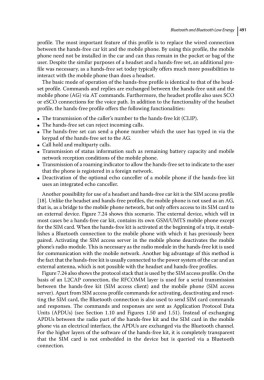Page 505 - From GMS to LTE
P. 505
Bluetooth and Bluetooth Low Energy 491
profile. The most important feature of this profile is to replace the wired connection
between the hands‐free car kit and the mobile phone. By using this profile, the mobile
phone need not be installed in the car and can thus remain in the pocket or bag of the
user. Despite the similar purposes of a headset and a hands‐free set, an additional pro-
file was necessary, as a hands‐free set today typically offers much more possibilities to
interact with the mobile phone than does a headset.
The basic mode of operation of the hands‐free profile is identical to that of the head-
set profile. Commands and replies are exchanged between the hands‐free unit and the
mobile phone (AG) via AT commands. Furthermore, the headset profile also uses SCO
or eSCO connections for the voice path. In addition to the functionality of the headset
profile, the hands‐free profile offers the following functionalities:
The transmission of the caller’s number to the hands‐free kit (CLIP).
●
The hands‐free set can reject incoming calls.
●
The hands‐free set can send a phone number which the user has typed in via the
●
keypad of the hands‐free set to the AG.
Call hold and multiparty calls.
●
Transmission of status information such as remaining battery capacity and mobile
●
network reception conditions of the mobile phone.
Transmission of a roaming indicator to allow the hands‐free set to indicate to the user
●
that the phone is registered in a foreign network.
Deactivation of the optional echo canceller of a mobile phone if the hands‐free kit
●
uses an integrated echo canceller.
Another possibility for use of a headset and hands‐free car kit is the SIM access profile
[18]. Unlike the headset and hands‐free profiles, the mobile phone is not used as an AG,
that is, as a bridge to the mobile phone network, but only offers access to its SIM card to
an external device. Figure 7.24 shows this scenario. The external device, which will in
most cases be a hands‐free car kit, contains its own GSM/UMTS mobile phone except
for the SIM card. When the hands‐free kit is activated at the beginning of a trip, it estab-
lishes a Bluetooth connection to the mobile phone with which it has previously been
paired. Activating the SIM access server in the mobile phone deactivates the mobile
phone’s radio module. This is necessary as the radio module in the hands‐free kit is used
for communication with the mobile network. Another big advantage of this method is
the fact that the hands‐free kit is usually connected to the power system of the car and an
external antenna, which is not possible with the headset and hands‐free profiles.
Figure 7.24 also shows the protocol stack that is used by the SIM access profile. On the
basis of an L2CAP connection, the RFCOMM layer is used for a serial transmission
between the hands‐free kit (SIM access client) and the mobile phone (SIM access
server). Apart from SIM access profile commands for activating, deactivating and reset-
ting the SIM card, the Bluetooth connection is also used to send SIM card commands
and responses. The commands and responses are sent as Application Protocol Data
Units (APDUs) (see Section 1.10 and Figures 1.50 and 1.51). Instead of exchanging
APDUs between the radio part of the hands‐free kit and the SIM card in the mobile
phone via an electrical interface, the APDUs are exchanged via the Bluetooth channel.
For the higher layers of the software of the hands‐free kit, it is completely transparent
that the SIM card is not embedded in the device but is queried via a Bluetooth
connection.

